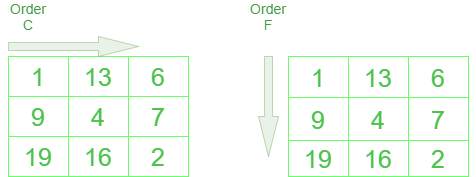Change the dimension of a NumPy array
Last Updated :
22 Mar, 2023
Let’s discuss how to change the dimensions of an array. In NumPy, this can be achieved in many ways. Let’s discuss each of them.
Method #1: Using Shape()
Syntax :
array_name.shape()
Python3
import numpy as np
def main():
print('Initialised array')
gfg = np.array([1, 2, 3, 4])
print(gfg)
print('current shape of the array')
print(gfg.shape)
print('changing shape to 2,2')
gfg.shape = (2, 2)
print(gfg)
if __name__ == "__main__":
main()
|
Output:
Initialised array
[1 2 3 4]
current shape of the array
(4,)
changing shape to 2,2
[[1 2]
[3 4]]
Method #2: Using reshape()
The order parameter of reshape() function is advanced and optional. The output differs when we use C and F because of the difference in the way in which NumPy changes the index of the resulting array. Order A makes NumPy choose the best possible order from C or F according to available size in a memory block.

Difference between Order C and F
Syntax :
numpy.reshape(array_name, newshape, order= 'C' or 'F' or 'A')
Python3
import numpy as np
def main():
gfg = np.arange(1, 10)
print('initialised array')
print(gfg)
print('3x3 order C array')
print(np.reshape(gfg, (3, 3), order='C'))
print('3x3 order F array')
print(np.reshape(gfg, (3, 3), order='F'))
print('3x3 order A array')
print(np.reshape(gfg, (3, 3), order='A'))
if __name__ == "__main__":
main()
|
Output :
initialised array
[1 2 3 4 5 6 7 8 9]
3x3 order C array
[[1 2 3]
[4 5 6]
[7 8 9]]
3x3 order F array
[[1 4 7]
[2 5 8]
[3 6 9]]
3x3 order A array
[[1 2 3]
[4 5 6]
[7 8 9]]
Method #3 : Using resize()
The shape of the array can also be changed using the resize() method. If the specified dimension is larger than the actual array, The extra spaces in the new array will be filled with repeated copies of the original array.
Syntax :
numpy.resize(a, new_shape)
Python3
import numpy as np
def main():
gfg = np.arange(1, 10)
print('initialised array')
print(gfg)
gfg1=np.resize(gfg, (3, 3))
print('3x3 array')
print(gfg1)
gfg2=np.resize(gfg, (4, 4))
print('4x4 array')
print(gfg2)
gfg.resize(5, 5)
print('5x5 array')
print(gfg)
if __name__ == "__main__":
main()
|
Output :
initialised array
[1 2 3 4 5 6 7 8 9]
3x3 array
[[1 2 3]
[4 5 6]
[7 8 9]]
4x4 array
[[1 2 3 4]
[5 6 7 8]
[9 1 2 3]
[4 5 6 7]]
5x5 array
[[1 2 3 4 5]
[6 7 8 9 0]
[0 0 0 0 0]
[0 0 0 0 0]
[0 0 0 0 0]]
Like Article
Suggest improvement
Share your thoughts in the comments
Please Login to comment...